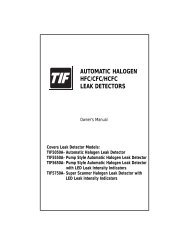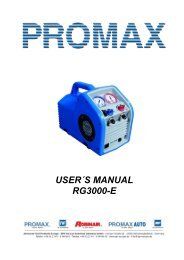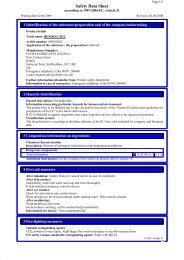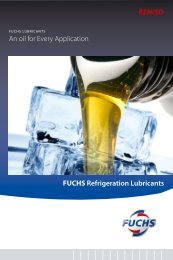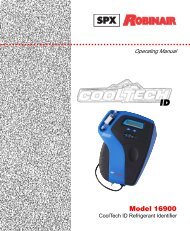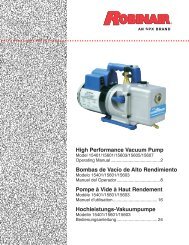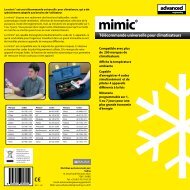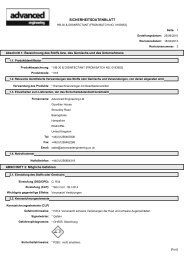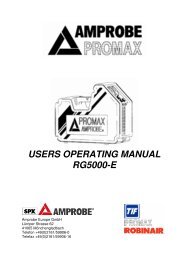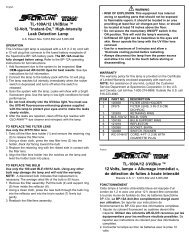users operating manual rg5410a-110v - Advanced Engineering
users operating manual rg5410a-110v - Advanced Engineering
users operating manual rg5410a-110v - Advanced Engineering
Create successful ePaper yourself
Turn your PDF publications into a flip-book with our unique Google optimized e-Paper software.
USERS OPERATING MANUAL<br />
RG5410A-110V<br />
Amprobe Europe GmbH<br />
Lürriper Strasse 62<br />
41065 Mönchengladbach<br />
Telefon +49(0)2161/59906-0<br />
Telefax +49(0)2161/59906-16
AMPROBE EUROPE<br />
RG5410A<br />
TABLE OF CONTENTS<br />
I) Safety precautions<br />
A) The safe way ist he only way! 1<br />
B) Refrigerant gas recovery & containment 2<br />
II) Important general information 3<br />
III)<br />
Operational procedures<br />
A) Operating your RG5410A 4-6<br />
B) Set-up procedures 7-9<br />
C) Purging the non-condensable gases 10<br />
IV)<br />
Diagrams<br />
A) Part list 11<br />
B) Refrigerant flow diagram 12<br />
C) Wiring diagram 13<br />
V) Safety pressure switch 14<br />
VI) Care and maintenance 15<br />
VII) Technical data 16<br />
VIII) Helpful hints 17-20<br />
IX) Troubleshooting 21<br />
Design specifications and material are subject to change without notice. REV082002TWH<br />
This <strong>manual</strong> may not be reproduced in any way, shape or form without express written consent of<br />
AMPROBE.
AMPROBE EUROPE<br />
RG5410A<br />
THE SAFE WAY IS THE ONLY WAY!<br />
NOTE! If you are not a qualified refrigerant service technician,<br />
do not use this equipment<br />
1. The technician should always wear goggles and gloves when working on refrigeration<br />
systems.<br />
2. Be sure that any room where you are working is thoroughly ventilated,<br />
3. Always think before acting. Familiarity breeds carelessness and carelessnesscan be<br />
harmful to your health or, worse, result in death.<br />
4. Read the Material Safety Data Sheets (MSDS) on all compounds with which you are<br />
likely to come in contact. Read MSDS on refrigerant and refrigerant oil. Obtain MSDS<br />
sheets from your refrigerant supplier.<br />
5. Never use oxygen when testing for leaks. Any oil in contact with oxygen under pressure<br />
will form an explosive mixture.<br />
6. Refrigerant systems are generally electrically driven and controlled. Be sure to<br />
disconnect the unit from the power source before servicing it.<br />
7. Always store refrigerant containers in a cool, dry place.<br />
8. Always open service and cylinder valves slowly. This allows quick control of the flow of<br />
gasses if there is any danger. Once it is determined that there is no danger, the valves<br />
may be opened fully.<br />
9. Do not mix refrigerant in a system, a tank or anywhere else. Each type of refrigerant<br />
must have its own tank, filters, etc.<br />
10. If moisture enters the refrigerant system, it is likely to cause considerable damage.<br />
Keep everything connected with the refrigeration system thoroughly dry and clean.<br />
11. To reduce the risk of fire, avoid the use of extension cords as they may overheat.If you<br />
must use an extension cord iit should be a minimum of 14 AWG and not longer than<br />
25ft.<br />
This<br />
equipment should be used in locations with mechanical ventilation providing at least<br />
four air changes per hour, or the equipment should be located at least 45cm (18”)<br />
above the floor. Do not use this equipment in the vicinity of spilled or open containers<br />
of gasoline or any other flammable liquid.<br />
- 1 -
AMPROBE EUROPE<br />
RG5410A<br />
REFRIGERANT GAS<br />
RECOVERY & CONTAINMENT<br />
Safety comes first. Read all safety information for the safe handling of refrigerant including<br />
the Material Safety Data Sheet provided by your refrigerant supplier. Never operate unit in<br />
an explosive environment. Wear safety glasses and protective gloves. Work area must be<br />
well ventilated. This unit should only be operated by a qualified technician.<br />
*** CAUTION: REFRIGERANT STORE CONTAINERS ***<br />
Use only approved cylinders with a minimum of 41 bar working pressure that serve the<br />
current regulations.<br />
NOTE: Recovery cylinders are designed for different pressures. Do not exceed the<br />
working pressure of each cylinder.<br />
Safety codes recommend that closed tanks not be filled over 80% of volume with liquid.<br />
The remaining 20% is called head pressure room.<br />
NEVER TRANSPORT AN OVERFILLED CYLINDER.<br />
Refrigerant expands when it gets warm and may cause a tank to explode if overfilled.<br />
CYLINDER TEMP. 16 °C 21 °C 38 °C 54 °C 66 °C<br />
STARTING WITH<br />
CYLINDER 80%<br />
FULL BY VOLUME<br />
SPACE OCCUPIED<br />
BY LIQUID<br />
80 % 81% 83% 90% 94%<br />
STARTING WITH<br />
CYLINDER 90%<br />
FULL BY VOLUME<br />
SPACE OCCUPIED<br />
BY LIQUID<br />
90% 92% 96% 100%<br />
- 2 -
AMPROBE EUROPE<br />
RG5410A<br />
IMPORTANT<br />
GENERAL INFORMATION<br />
Before <strong>operating</strong> the RG5410A recovery unit, read the following:<br />
1. Always isolate large amounts of refrigerant and close off valves after use so if a leak<br />
should develop anywhere in the system the refrigerant does not escape.<br />
2. Storage cylinders sometimes have valves that are not properly seated when<br />
manufactured. Keeping caps on these valves will guard against refrigerant leakage.<br />
3. Always operate the unit on a flat level surface.<br />
4. Your RG5410A has one internal pressure shut off switche. If the pressure inside the<br />
system should go above 38,5 bar (550 psi), the system will automatically shut itself off.<br />
CAUTION<br />
The 38,5 bar (550 psi) switch does not prevent tank overfill. If your system shuts<br />
off on high pressure and is connected to your tank, you may have overfilled your<br />
tank and created a very dangerous situation! Take immediate measures to relieve<br />
any high pressure and/or tank overfill.<br />
5. WARNING! Never overfill storage tanks. Overfilling may cause tanks to explode.<br />
6. A scale must be used to avoid overfilling the storage tank.<br />
7. Tanks and filters should be designated for one refrigerant only. Before using a tank<br />
previously used for another refrigerant, completely empty the tank, evacuate it, purge<br />
the tank using dry nitrogen, and re-evacuate it.<br />
8. Special care should be taken when recovering from a burned-out system. Use two high<br />
acid capacity filters, in series. Alco type EK-162-F or Sporlan type C-162-F are<br />
recommended.<br />
9. When you have finished recovering from the system, flush your RG5410A with a small<br />
amount of refrigerant oil and a small amount of clean refrigerant to purge off any foreign<br />
substances left in the unit.<br />
10. Always empty refrigerant from the unit into a storage tank; see Self Purge/Auto<br />
Evacuate procedure. Liquid refrigerant left in the condenser may expand, causing<br />
damage to components.<br />
- 3 -
AMPROBE EUROPE<br />
RG5410A<br />
OPERATING YOUR RG5410A<br />
Connect your RG5410A to a 110 V outlet. Switch the main power switch to the ON<br />
position. You should hear the fan running. Press the compressor start switch. This<br />
"momentary" switch will start the compressor. It may be necessary, under certain<br />
circumstances, to press this switch more than once to start the compressor.<br />
OPERATIONAL PROCEDURES<br />
NORMAL RECOVERY<br />
Do not turn this valve<br />
while unit is running.<br />
Close input valve, turn<br />
machine off, switch to<br />
Purge position and restart<br />
machine.<br />
SELF PURGE / AUTO EVACUATE<br />
Do not turn this valve<br />
while unit is running.<br />
Close input valve, turn<br />
machine off, switch to<br />
Purge position and restart<br />
machine.<br />
NOTE:<br />
To change from Recovery mode to Purge:<br />
Close the Input port, turn the unit off (to prevent high pressure shutoff), switch to<br />
Purge position and restart the unit.<br />
- 4 -
AMPROBE EUROPE<br />
RG5410A<br />
OPERATING YOUR RG5410A<br />
Procedure for Normal System Recovery<br />
1. Inspect the RG5410A thoroughly to insure that it is in good <strong>operating</strong> condition.<br />
2. Make sure all connections are correct and tight.<br />
3. Open the liquid port of the recovery cylinder (always open valves slowly to check hoses<br />
and connections for leaks).<br />
4. Make sure the Recover/Purge valve is set on Recover.<br />
5. Open the output port of the RG5410A.<br />
6. Open the liquid port on the manifold gauge set; opening the liquid port will remove the<br />
liquid from the system first, greatly reducing the recovery time (after the liquid has been<br />
removed, open the manifold vapor port to finish evacuating the system).<br />
7. Connect your RG5410A to a 110 V outlet.<br />
a) Switch the main power switch to the ON position. You should hear the<br />
fan running.<br />
b) Press the compressor start switch. This "momentary" switch will start<br />
the compressor (it may be necessary, under certain circumstances, to<br />
press this switch more than once to start the compressor).<br />
8. Slowly open the input port on the RG5410A.<br />
a) If the compressor starts to knock, slowly throttle back the input valve<br />
until the knocking stops.<br />
b) If the input valve was throttled back, it should be fully opened once the<br />
liquid has been removed from the system (the manifold vapor port<br />
should also be opened at this time).<br />
9. Run until minimum EPA required vacuum is achieved.<br />
a) Close the manifold vapor and liquid ports.<br />
b) Close the RG5410A input port.<br />
c) Shut unit off and proceed with the Self Purge procedure on the next<br />
page.<br />
10. Always purge the RG5410A after each use. Failure to purge the remaining refrigerant<br />
from the RG5410A could result in the acidic degradation of internal components,<br />
ultimately causing premature failure of the unit.<br />
CAUTION<br />
When pumping liquid, do not allow the RG5410A to operate with the input valve<br />
too far open, causing the compressor to knock. Doing so may stall the<br />
compressor.<br />
- 5 -
AMPROBE EUROPE<br />
RG5410A<br />
OPERATING YOUR RG5410A<br />
Procedure for Purging Remaining Refrigerant From the RG5410A<br />
1. Close the ports of the system being serviced that are connected to the input port<br />
of the RG5410A.<br />
2. Close the input port on the RG5410A.<br />
3. Turn off RG5410A.<br />
4. Turn the Recover/Purge valve to the purge position.<br />
5. Restart the RG5410A.<br />
6. Run until desired vacuum is achieved.<br />
7. Close the ports on the recovery tank and the RG5410A.<br />
8. Turn the RG5410A off.<br />
9. Return the Recover/Purge valve to the recover position.<br />
10. Disconnect and store all hoses.<br />
11. Replace the in-line filter on your RG5410A after every time excessive contaminant is<br />
encountered.<br />
- 6 -
AMPROBE EUROPE<br />
RG5410A<br />
RG5410A REFRIGERANT RECOVERY<br />
ADDITIONAL INFORMATION<br />
To achieve the deepest final vacuum, use the tank cooling method to lower the head<br />
pressure on the recovery tank. Repeat as necessary to achieve the desired vacuum level.<br />
NOTE: If there is no liquid in the recovery tank, then the cooling method will not work. In this<br />
case, use an empty tank that has been fully evacuated to achieve the final vacuum level<br />
required.<br />
To maximize recovery rates use the shortest possible length of 3/8” or larger hose. A hose<br />
no longer than 3’0” is recommend. Always remove all unnecessary hose core depressors<br />
and Schrader valves from port connections (using the proper valve core tool) for maximum<br />
throughput. Deformed rubber seals and core depressors in hoses and faulty or<br />
unnecessary Schrader valves can restrict flow by up to 90%.<br />
If the tank pressure exceeds 31,5 bar, use the tank cooling procedure to reduce the tank<br />
pressure. When recovering large amounts of liquid, use the “PUSH/PULL” method of<br />
recovery (see diagram below).<br />
CAUTION: When using the “PUSH/PULL” method, you must use a scale to prevent<br />
overfilling the storage tank. Once the “PUSH/PULL” siphon is started, it can continue and<br />
overfill the storage tank even if the tank is equipped with a float level sensor. The siphon<br />
can continue even when the machine is turned off. You must <strong>manual</strong>ly close the valves on<br />
the tank and the unit to prevent overfilling the recovery tank.<br />
SET-UP DIAGRAM FOR TANK PRE OR SUB COOLING<br />
PROCEDURE<br />
INPUT<br />
VAPOR<br />
OUTPUT<br />
LIQUID<br />
To start you must have a minimum of<br />
2,5 kg of liquid refrigerant in the tank.<br />
Throttle the output valve so that the<br />
output pressure is 7 bar (100 psi)<br />
greater than the input pressure, but<br />
never more than 31,5 bar (450 psi).<br />
Run until the tank is cold.<br />
- 7 -
AMPROBE EUROPE<br />
RG5410A<br />
SET-UP DIAGRAM FOR REFRIGERANT RECOVERY<br />
This method is the fastest method for recovering vapor refrigerant.<br />
(OPTIONAL) MOISTURE<br />
SIGHT GLASS<br />
MANIFOLD GAUGE SET<br />
INPUT<br />
SYSTEM<br />
BEING<br />
SERVICED<br />
VAPOR<br />
OUTPUT<br />
LIQUID<br />
LIQUID<br />
A scale must be used<br />
to avoid overfilling the<br />
storage tank.<br />
SET-UP DIAGRAM FOR “PUSH/PULL” METHOD<br />
Push pull only works with large systems where the liquid is readily accessible. Do not use<br />
this method on systems that contain less than 15 pounds as it may not work.<br />
SYSTEM<br />
BEING<br />
SERVICED<br />
LIQUID<br />
VAPOR<br />
INPUT<br />
VAPOR<br />
OUTPUT<br />
LIQUID<br />
OPTIONAL MOISTURE<br />
INDICATING SIGHT GLASS<br />
A scale must be<br />
used to avoid<br />
overfilling the<br />
storage tank.<br />
The sight glass is used to provide a method of<br />
determining the moisture content and quality of a<br />
system’s refrigerant.<br />
- 8 -
AMPROBE EUROPE<br />
RG5410A<br />
OPTIONAL RECOVERY / TANK PRE OR SUB COOLING<br />
FOR FIXED HOSE SET UP<br />
MANIFOLD GAUGE SET<br />
INPUT<br />
SYSTEM<br />
BEING<br />
SERVICED<br />
VAPOR<br />
OUTPUT<br />
LIQUID<br />
VAPOR<br />
LIQUID<br />
A scale must be used<br />
to avoid overfilling the<br />
storage tank.<br />
Normal recovery:<br />
Tank Vapor valve is closed.<br />
Tank pre or sub cooling:<br />
Tank Vapor valve is open and both Manifold Gauge Set valves are closed. Follow above<br />
procedure.<br />
- 9 -
AMPROBE EUROPE<br />
RG5410A<br />
RG5410A RECOVERY<br />
Purging the non-condensable gasses from identified refrigerant in a tank<br />
1. Allow the tank to sit undisturbed for 24 hours. (This allows the air to rise to the top).<br />
2. Connect a manifold to the tank and read the amount of pressure in the tank by looking<br />
at the output pressure gauge.<br />
3. Determine the ambient temperature in the room.<br />
4. Refer to a Refrigerant pressure/temperature chart. Find the temperature on the chart<br />
and look across to the corresponding pressure for the type of refrigerant in the tank.<br />
Determine how that relates to the reading on the gauge.<br />
5. If the pressure reading is higher than the pressure shown on the chart, very slowly (so as<br />
not to cause turbulence inside the tank) crack open the vapor port valve. Watch the<br />
pressure on the gauge decrease. To prevent venting, add 0,3 - 0,35 bar (4 - 5 psi) to<br />
the pressure shown on the chart. When the gauge corresponds to that pressure, close<br />
the vapor port valve.<br />
6. Allow the tank to sit for 10 minutes and check the pressure again.<br />
7. Repeat the process again if necessary.<br />
- 10 -
AMPROBE EUROPE<br />
RG5410A<br />
PARTS LIST RG5410A<br />
Pos. Bezeichnung Teilenr.<br />
1 Plasic case 100134 L&R<br />
2 Fan grill 100505<br />
3 Axial fan EL1817<br />
4 Condenser 100978<br />
5 Motor EL1821<br />
6 Coupler CP1315<br />
7 Bell housing CP1001<br />
8 Compressor CP1320<br />
9 Input gauge GA1500<br />
10 Output gauge GA0800<br />
11 Gauge lens GA1000<br />
12 ON/OFF switch EL1310<br />
13 Starts switch EL1309<br />
14 Blue knob 100123<br />
15 Red knob 100124<br />
16 Black knob 100122<br />
17 Frontpanel 100137<br />
18 Filter 100343<br />
19 Flare cap NB6501<br />
20 Powercord 100520<br />
21 Pressure switch EL2802<br />
22 Rear panel 100318<br />
23 Manifold 700133<br />
24 Capacitor EL1412<br />
25 Capacitor holder 100208<br />
26 Compressorbracket 100207<br />
27 Hose 4“ 100345<br />
Parts 24 and 25 are not shown in the<br />
drawing.<br />
- 11 -
AMPROBE EUROPE<br />
RG5410A<br />
REFRIGERANT FLOW DIAGRAM<br />
CONDENSER COMPRESSOR<br />
MOTOR<br />
OUTPUT<br />
- 12 -<br />
INPUT<br />
FILTER<br />
NOTE: A filter must always be used. Failure to use a filter will invalidate your warranty.<br />
The use of a filter will greatly reduce the risk of damage to your RG5410A by preventing foreign material from<br />
entering the unit.<br />
Special consideration for filtration must be given when you know you are servicing a machine that has "Burned Out".<br />
We recommend the use of two size 162 filter driers, in line, to be used for that job and that job only.
AMPROBE EUROPE<br />
RG5410A<br />
wht<br />
RG5410A WIRING DIAGRAM<br />
Plug AC Male<br />
Power switch<br />
High pressure switch<br />
blk<br />
red red<br />
grn<br />
brn<br />
grn<br />
Fan motor<br />
wht<br />
3<br />
3 pin connector for<br />
up-grade<br />
brn<br />
7<br />
6<br />
1/2 HP motor<br />
2<br />
yel blu<br />
Start switch<br />
5<br />
1<br />
- 13 -
AMPROBE EUROPE<br />
RG5410A<br />
.SAFETY PRESSURE SWITCH (WITH<br />
MANUAL RESET FUNCTION)<br />
The RG5410A is equipped with an internal Safety Pressure Switch. If the pressure inside<br />
the system exceeds 38,5 bar, the system is switched off automatically.<br />
If the Safety Pressure Switch is activated automatically whilst filling a bottle, it could be<br />
caused by the bottle becoming overfilled.<br />
This is a very dangerous situation! You should take steps immediately to reduce the<br />
overpressure and/or to eliminate the overfilling of the bottle.<br />
If the Safety Pressure Switch switches the unit off...<br />
The following precautions should be taken if the Safety Pressure Switch is activated:<br />
a) Suspected overfilling of the recovery bottle<br />
Connect the recovery bottle to another bottle with spare capacity so that the pressure is<br />
reduced to a safe level. This action should also reduce the pressure in the output line from<br />
the RG5410A. Proceed as normal after resetting the Safety Pressure Switch (see below).<br />
b) Cause of activation of Safety Pressure Switch unknown<br />
1) Check that the recovery bottle is not overfilled.<br />
2) Close the system valves, recovery bottle valves and RG5410A valves.<br />
3) Disconnect RG5410A from flexible pipes.<br />
4) Disconnect RG5410A from the power supply.<br />
5) Open the input and output valves very slowly.<br />
6) Investigate the reason for the failure.<br />
Once activated the Safety Pressure Switch has to be reset <strong>manual</strong>ly as follows:<br />
I) Remove the black protection cover to reveal the reset button (see picture below).<br />
II) Reset by pushing the reset button with a tool such as a screwdriver.<br />
III) Replace the cover.<br />
Remove this part in order to<br />
Reset the pressure switch.<br />
- 14 -
AMPROBE EUROPE<br />
RG5410A<br />
CARE AND MAINTENANCE OF YOUR<br />
RG5410A<br />
A filter must always be used and should be replaced frequently. Failure to use a filter will<br />
invalidate your warranty. The use of a filter will greatly reduce the risk of damage to your<br />
RG5410A by preventing foreign material from entering the unit.<br />
Special consideration for filtration must be given when you know the machine you are<br />
servicing has "burned out". We recommend the use of two size 162 filter driers, in line, to<br />
be used for that job and that job only. We also recommend that a clean filter be used for<br />
every service job. Each filter should be labeled and used exclusively for one type of<br />
refrigerant only.<br />
Do not use this unit in the vicinity of spilled or open containers of gasoline or other<br />
combustible liquids<br />
Avoid the use of extension cords. If you must use an extension cord it should be a minimum<br />
of 14 AWG and not longer than 25 ft. Not using an extension cord will greatly reduce the<br />
risk of fire.<br />
Always purge the unit of any refrigerant left after completing a service job. Refrigerant left in<br />
the machine can expand and may cause damage to components.<br />
If the unit is to be stored or not used for any length of time, we recommend that it be<br />
completely evacuated of any residual refrigerant and purged with dry nitrogen.<br />
Whenever you perform any type of maintenance work on your RG5410A, insure that it is<br />
disconnected from the power supply before you begin.<br />
- 15 -
AMPROBE EUROPE<br />
RG5410A<br />
TECHNICAL SPECIFICATIONS<br />
RG5410A<br />
Type<br />
Application<br />
Suitable refrigerants<br />
Power Source<br />
Power<br />
Dimensions<br />
Weight<br />
RG5410A<br />
Refrigerant recovery Gas or Vapor<br />
R12, R22, R134A, R401A, R401B, R401C, R402A, R402B,<br />
R404A, R406A, R407A, R407B, R407C, R407D, R408A,<br />
R409A, R410A, R411A, R411B, R412A, R500, R502, R507,<br />
R509<br />
110V / 50 Hz<br />
380 W<br />
330 x 229 x 483 mm<br />
14,5 kg<br />
Recovery Rate Vapor: up to 33 kg/h<br />
Liquid:<br />
up to 80 kg/h<br />
Push Pull:<br />
up to 380 kg/h<br />
Displacement 8,2 cm 3 (1/2 cubic inch)<br />
RPM´s<br />
Max. working pressure<br />
Safety Device<br />
1437 U/min<br />
550 p.s.i. (38,5 bar)<br />
Safety pressure switch type P100 DA<br />
with <strong>manual</strong> reset (550 p.s.i. / 38,5 bar)<br />
ATTENTION<br />
The RG5410A should not be used with inflammable gases nor with<br />
gases containing ammonia.<br />
- 16 -
AMPROBE EUROPE<br />
RG5410A<br />
HELPFUL HINTS FOR REFRIGERANT<br />
RECOVERY<br />
Refrigerant recovery has come a long way in a few short years.<br />
On the surface it’s simply the process of taking refrigerant out of a system and putting it into<br />
a tank. However, this simple process can quickly become problematic if a few items are<br />
overlooked. The following are some tips and pointers we’ve accumulated over the last few<br />
years that can save you time and make the process go smoother.<br />
First you need to identify the refrigerant type and quantity in the system you are<br />
servicing.<br />
If you determine it’s a burnout, you need a special tank (a tank that’s identified as<br />
containing burnout or other unidentified gases), and you need to use extra filtration prior to<br />
recovery.<br />
If, on the other hand, you know the gas in the system is relatively clean or new, then a new<br />
tank should be used. If you’re planning on putting the refrigerant back into the same system<br />
after you have finished the service or if the refrigerant is going to be reclaimed, then use a<br />
tank that has the same refrigerant in it. A word of caution about the Environmental<br />
Protection Agency (EPA): If you use a variety of refrigerant gasses in your service work -<br />
as evidenced by your refrigerant purchases - and you only own one tank, you are asking for<br />
trouble. You would be well advised to own at least one tank for every refrigerant type<br />
serviced, plus an extra for burnouts and other unknowns.<br />
Planning Ahead<br />
Knowing the quantity of refrigerant is important for planning storage requirements, as well<br />
as planning for the actual recovery. For instance, any system with more than 5lbs. of<br />
refrigerant is likely to have areas where the liquid can get trapped.<br />
The key to a quick recovery procedure is to get the liquid out first, and then get the<br />
remaining vapor out. However most systems are not “recovery friendly.” That is they don’t<br />
have access ports at their lowest points. If some units you’re servicing are on maintenance<br />
contracts, you would save significant time by installing access ports at all of the lowest<br />
points in the system, where liquid is likely to accumulate. Since most systems don’t have<br />
these ports you need to be prepared to boil of the trapped liquid with a heat gun, when ever<br />
it’s found. An indicator of trapped liquid in a system is frost or condensation forming on the<br />
plumbing or components where the liquid is trapped. The trapped liquid may be in an area<br />
that is not visible. In all cases trapped liquid in a system during recovery causes the<br />
recovery process to slow down, regardless of the size or type of machine<br />
If you are unable to locate the trapped liquid (but you know it’s there, because the recovery<br />
job is taking “forever”), turn on the system compressor (if it’s operable) for a few seconds.<br />
This will get the refrigerant moving to another part of the system and in.<br />
- 17 -
AMPROBE EUROPE<br />
RG5410A<br />
HOSES AND VALVES<br />
Hoses and Schraeder valves have a large impact on recovery speed. In general, the larger<br />
the hose, the less friction on the flow of refrigerant, the quicker the recovery time. Many<br />
contractors are now using 3/8” lines for the input to the recovery machine, even if those<br />
lines originate out of 1/4” fittings.<br />
Schraeder valves must be removed from the connection prior to an expedient<br />
recovery. Most wholesalers sell a tool for removing these cores, while keeping the<br />
connection sealed. The core depressor, in the end of the hose, should also be removed.<br />
These two items can turn a 20 minute job into one that goes on for hours. So, be sure to<br />
remove Schraeder valves and core depressors before every recovery job.<br />
Another hose consideration is the little rubber grommet at the end of the hose that makes a<br />
seal with the flare fitting. We’ve seen these seals so worm and deformed that when the<br />
hose is connected to the flare fitting the grommet virtually seals off the the connection. This<br />
is probably never noticed in charging, because the pressure opens the grommet, but<br />
during recovery (or with suction) the deformed grommet severely restricts the flow of<br />
refrigerant.<br />
Refrigerant Recycling<br />
Current regulations state that used refrigerant shall not be sold, or used in a different<br />
owner’s equipment, unless the refrigerant has been laboratory analyzed and found to meet<br />
the requirements of ARI 700 (latest edition). As a result, recycling and verifying ARI 700<br />
conformance isn’t economically justified in most cases. It’s still a great idea to do as much<br />
cleaning of refrigerant going back into the same system (or owners<br />
system) as possible. We recommend using the largest, high-acid capacity filter that are<br />
economically feasIble. Put these filters on the suction or inlet side of the recovery unit.<br />
Change filters often.<br />
The recovery of large amounts of liquid refrigerant can sometimes carry with it large<br />
quantities of oil, if the system being serviced doesn’t have an adequate oil separator<br />
installed. If this recovered refrigerant isn’t going to be liquid charged back into the same<br />
system, you might want to separate the refrigerant from the oil in order to<br />
measure the oil (to know how much oil to charge back into the system). However refrigerant<br />
sent back for reclaim does not need to have the oil removed. One of the simplest and most<br />
cost effective ways to achieve this is to use a 30 or 50 lb. tank in line with your recovery<br />
machine. Connect the the system to the liquid port of the tank then from the vapor port of<br />
the tank connect to the input of your recovery machine a second tank, for storing refrigerant,<br />
should then be connected to the output of the recovery machine. If you encounter large<br />
amounts of liquid you will need to put a band heater around the first tank.<br />
When the recovery job is complete the oil can be removed, from the first tank, by applying<br />
a small amount of pressure, using nitrogen, to one of the ports and<br />
expressing the oil from the other. If you are going to remove the oil from the vapor port you<br />
will need to turn the tank upside down. Always wear safety glasses when<br />
performing this operation as the oil may be acidic and could cause severe burning.<br />
- 18 -
AMPROBE EUROPE<br />
RG5410A<br />
KEEPING THE DIRT OUT<br />
During the recovery process your recovery machine can be exposed to debris that can,<br />
potentially, damage it. Including brazing spatter and copper and brass slithers. Further<br />
contamination can be introduced from the refrigerant storage tanks. To<br />
prolong the life of your recovery machine always use an in-line filter.<br />
Whenever you are charging a system from a recovery cylinder it is a good idea to use an<br />
in-line filter to protect the system from contamination. Again, change your<br />
in-line filters often.<br />
Getting the Liquid Out (See “Push/Pull-Method”)<br />
Push-pull is a method of removing bulk liquid from a system using the pressure<br />
differential created by the recovery machine. Push-pull will generally not work on smaller<br />
systems because there is no bulk liquid reservoir to create a siphon from.<br />
Push-pull is mostly used on systems with a receiver tank or those with greater than 20 lbs.<br />
of refrigerant, or when transferring from one tank to another. The rate of liquid transfer id<br />
very much dependent on hose size, with larger hoses providing much<br />
better throughput.<br />
Another trick is to chill the tank, if it’s partially filled, prior or during recovery. This operation<br />
will lower the pressure in the storage tank and therefore speed up recovery.<br />
There must be a minimum of 5 lbs of liquid refrigerant in the tank you wish to chill. This<br />
operation can be performed prior to or during the recovery. See the two set up diagrams<br />
and procedures on page 8 of this <strong>manual</strong>.<br />
There is nothing magic here, you are simply using your recovery machine to make a<br />
refrigerator where the tank is the evaporator. By throttling the output valve, you’re effectively<br />
creating a capillary tube or an expansion device, but you need to adjust the back pressure<br />
to suit the conditions and the refrigerant. Five to ten minutes of chilling can produce some<br />
very dramatic tank cooling, depending on the conditions. If there are any non condensibles<br />
in the tank this process will not work. Also the greater the quantity of refrigerant in the tank<br />
the longer the process will take.<br />
- 19 -
AMPROBE EUROPE<br />
RG5410A<br />
TROUBLESHOOTING YOUR RG5410A<br />
The save way is the only way<br />
Read and understand all safety information contained in this<br />
<strong>manual</strong> before servicing the unit.<br />
Connect unit to 110 V outlet<br />
yes<br />
Fan is running when power<br />
switch is in "ON" position?<br />
yes<br />
Compressor starts when<br />
start switch is pressed<br />
no<br />
no<br />
Power supply ok?<br />
yes<br />
Is unit in high pressure shut<br />
off?<br />
no<br />
C<br />
O<br />
N<br />
T<br />
A<br />
C<br />
T<br />
yes<br />
Unit pumps into high<br />
pressure shut off?<br />
yes<br />
Unit pulls into a vacuum?<br />
yes<br />
no<br />
Are valves open?<br />
Reset button pushed?<br />
Are your hoses tight? Do<br />
you have leaks?<br />
TROUBLESHOOTING ENDS<br />
ye<br />
yes<br />
no<br />
yes<br />
P<br />
R<br />
O<br />
M<br />
A<br />
X<br />
S<br />
E<br />
R<br />
V<br />
I<br />
C<br />
E<br />
- 20 -



